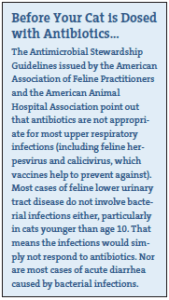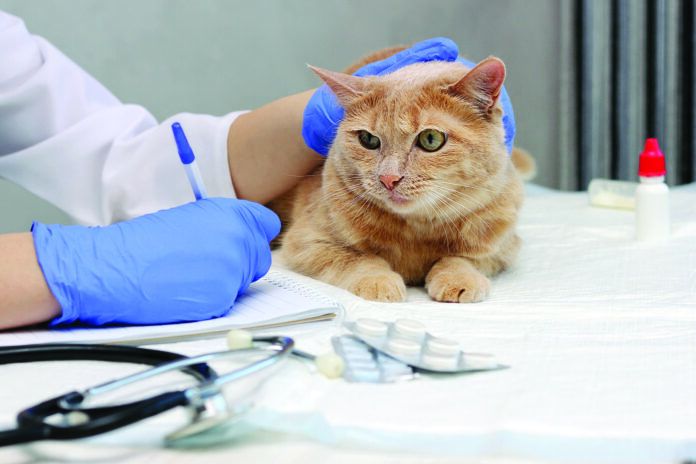You’ve probably heard of antibiotic resistance — the ability of bacteria that are causing an infection to resist the antibiotics prescribed to kill them. That means the antibiotics have a reduced chance of curing an illness brought on by the growth of harmful bacteria, whether it’s a respiratory infection causing breathing problems, a gastrointestinal infection causing diarrhea or vomiting, or some other type of infection.
Part of the reason bacteria come to be able to resist the power of antibiotics and keep multiplying at an infection site rather than die off is that antibiotics are overused. The more they are used, the better the chance the harmful bacteria have of mutating so that the next bacterial generation has the genetic makeup to ignore or withstand the drugs.
It’s a growing threat not only to human health but also to feline health, say the American Association of Feline Practitioners and the American Animal Hospital Association. That’s why the two groups have just introduced Antimicrobial Stewardship Guidelines that urge veterinarians, and by extension cat owners, to follow principles set forth by the American Veterinary Medical Association to help tamp down on antibiotic resistance. “Antimicrobial” is a term that encompasses “antibiotic.”
Nuts and bolts
The new guidelines outline a number of steps that should be taken to prevent the overuse of antibiotics. The most salient ones:
Consider “watchful waiting” to ascertain whether a cat truly needs antibiotics. Just because a cat has an infection doesn’t automatically mean he needs antibiotics to vanquish it. Antibiotics are not even helpful with viral infections because they don’t kill viruses. Sometimes even with bacterial infections the feline body’s immune system can mount a successful enough attack on the invader on its own. Veterinarians should provide pet owners with instructions on when and why to follow up with the doctor and also give recommendations for non-antibiotic approaches to improve their cat’s comfort. This will help owners remain vigilant in looking for important signs as well as in determining whether a follow-up assessment is needed.
- Employ antimicrobial “time outs.” This is a reassessment of the choice of antibiotic and whether it continues to be needed 48 to 72 hours after it is first administered. That’s because two to three days later, the clinical picture becomes clearer and more diagnostic information becomes available. In some cases it is found that antibiotics may be stopped because the updated information demonstrates that they are no longer necessary.
- Use alternatives to oral antibiotics when possible. Sometimes a cat doesn’t need to take an antibiotic by mouth that will have an impact on his entire body. Antiseptic baths, sprays, and ointments may be able to do the trick. Even changes to the diet can in certain cases help lick an illness.
- Rule out illnesses for which an antibiotic would prove useless. Antibiotics kill bacteria. Not only don’t they kill viruses but they are also ineffective in vanquishing parasites and other foreign invaders that cause illness.
 As part of antimicrobial stewardship, practice proper hygiene and other preventive health care when it comes to your cat: regular teeth brushing, keeping vaccinations up to date, and avoiding poor ventilation. Not engaging in these tactics provides environments where harmful bacteria can thrive.
As part of antimicrobial stewardship, practice proper hygiene and other preventive health care when it comes to your cat: regular teeth brushing, keeping vaccinations up to date, and avoiding poor ventilation. Not engaging in these tactics provides environments where harmful bacteria can thrive.





On antibiotics-check out “The New Natural Cat” by Anitra Frazier. Ok, it’s an older book, but has lotsa info.
I had a cat who was very prone to sinus infections due to allergies. Even with allergy shot he would get them. At the end nothing worked, he was so miserable we ended up letting him go. We switched vets. this one just give him a pill and a shot and bye. We asked him to look into the cause, he said there was nothing he could do. Would finding out what he was allergic to helped?